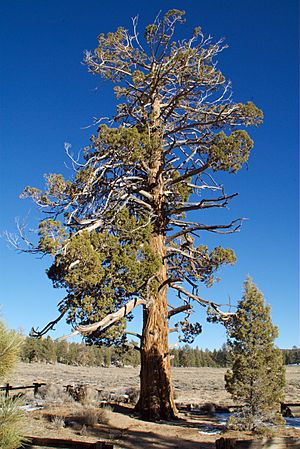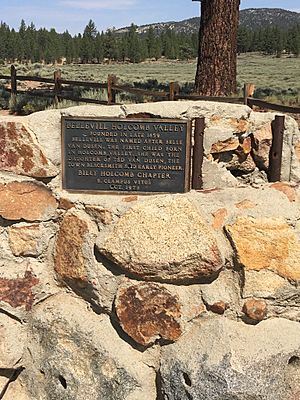Holcomb Valley facts for kids
Holcomb Valley is a historic place in the San Bernardino Mountains of Southern California. It's famous for having the most gold mines in the region. The valley is named after William F. Holcomb, who discovered gold there in 1860. This discovery led to the biggest gold rush in Southern California's history! A busy town called Belleville quickly grew up nearby, but it was abandoned after about ten years. Today, Holcomb Valley is recognized as California Historical Landmark #619.
Contents
Discovering Gold in Holcomb Valley
In May 1860, gold was found in Holcomb Valley by William F. Holcomb and Ben Choteau. They were miners who had been looking for gold in Bear Valley. Holcomb found the gold while he was tracking a bear in the valley, which was later named after him.
The Gold Rush Begins
After Holcomb and Ben Ware officially claimed five mining spots in May 1860, news spread fast. Many prospectors rushed to the area, hoping to find their own fortune.
Belleville: A Gold Rush Town
Soon, a gold camp appeared very close to where the gold was found. This camp quickly grew into a town. After the first child born there, a girl named Belle, the new town was named Belleville in her honor. It quickly became the largest town in San Bernardino County, with about 1,500 people.
Belleville was a rough and busy place. People were often competing over gold. It was known for its quick and sometimes harsh justice. During its busiest years, Belleville was one of the largest towns in Southern California.
The End of the Gold Rush
Holcomb Valley produced more gold than any other mining area in Southern California. However, over time, the main ways of mining gold (called placer and quartz mining) started to slow down. Most of the people living in Belleville left after 1870.
Mining Continues
Even after most people left, some harder rock mining continued at the Gold Mountain Mine until 1919. Today, some mining still happens, with about 2,000 claims made by people who enjoy mining as a hobby.
Holcomb Valley Today
The valley is also home to the Holcomb Valley Scout Ranch. This ranch, which used to be the Hitchcock Ranch, gives young people a chance to experience ranching, hiking, and other outdoor activities.
See also
- In Spanish: Valle de Holcomb para niños



